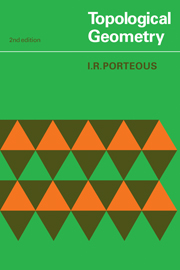Book contents
- Frontmatter
- Contents
- FOREWORD
- CHAPTER 0 GUIDE
- CHAPTER 1 MAPS
- CHAPTER 2 REAL AND COMPLEX NUMBERS
- CHAPTER 3 LINEAR SPACES
- CHAPTER 4 AFFINE SPACES
- CHAPTER 5 QUOTIENT STRUCTURES
- CHAPTER 6 FINITE-DIMENSIONAL SPACES
- CHAPTER 7 DETERMINANTS
- CHAPTER 8 DIRECT SUM
- CHAPTER 9 ORTHOGONAL SPACES
- CHAPTER 10 QUATERNIONS
- CHAPTER 11 CORRELATIONS
- CHAPTER 12 QUADRIC GRASSMANNIANS
- CHAPTER 13 CLIFFORD ALGEBRAS
- CHAPTER 14 THE CAYLEY ALGEBRA
- CHAPTER 15 NORMED LINEAR SPACES
- CHAPTER 16 TOPOLOGICAL SPACES
- CHAPTER 17 TOPOLOGICAL GROUPS AND MANIFOLDS
- CHAPTER 18 AFFINE APPROXIMATION
- CHAPTER 19 THE INVERSE FUNCTION THEOREM
- CHAPTER 20 SMOOTH MANIFOLDS
- CHAPTER 21 TRIALITY
- BIBLIOGRAPHY
- LIST OF SYMBOLS
- INDEX
CHAPTER 2 - REAL AND COMPLEX NUMBERS
Published online by Cambridge University Press: 06 January 2010
- Frontmatter
- Contents
- FOREWORD
- CHAPTER 0 GUIDE
- CHAPTER 1 MAPS
- CHAPTER 2 REAL AND COMPLEX NUMBERS
- CHAPTER 3 LINEAR SPACES
- CHAPTER 4 AFFINE SPACES
- CHAPTER 5 QUOTIENT STRUCTURES
- CHAPTER 6 FINITE-DIMENSIONAL SPACES
- CHAPTER 7 DETERMINANTS
- CHAPTER 8 DIRECT SUM
- CHAPTER 9 ORTHOGONAL SPACES
- CHAPTER 10 QUATERNIONS
- CHAPTER 11 CORRELATIONS
- CHAPTER 12 QUADRIC GRASSMANNIANS
- CHAPTER 13 CLIFFORD ALGEBRAS
- CHAPTER 14 THE CAYLEY ALGEBRA
- CHAPTER 15 NORMED LINEAR SPACES
- CHAPTER 16 TOPOLOGICAL SPACES
- CHAPTER 17 TOPOLOGICAL GROUPS AND MANIFOLDS
- CHAPTER 18 AFFINE APPROXIMATION
- CHAPTER 19 THE INVERSE FUNCTION THEOREM
- CHAPTER 20 SMOOTH MANIFOLDS
- CHAPTER 21 TRIALITY
- BIBLIOGRAPHY
- LIST OF SYMBOLS
- INDEX
Summary
In this chapter we discuss briefly the definitions of group, ring and field and the additive, multiplicative and order properties of the ring of integersZ and the rational, real and complex fieldsQ, R and C. Since there are many detailed accounts of these topics available, most of the proofs are omitted. For more details of the construction of R see, for example,.
Groups
Products on a set were defined in Chapter 1, and we have already encountered several specimens, for example, composition either on XX or on X!, where X is any set. Further examples are union and intersection on Sub X, and addition, multiplication and exponentiation on the set of natural numbers ω.
A group consists of a set, G, say, and a product with unity on G that is associative and admits inverses, such a product being said to be a group structure for the set G.
For example, composition is a group structure for X!. This group is called the group of permutations of X. On the other hand composition is not a group structure for Xx, unless # X = 0 or 1, for in all other cases there exist non-invertible transformations of X.
A set may have many group structures. When we are only interested in one such structure it is common practice to use the same letter, G, say, to denote both the group and the underlying set, and to use the notational conventions of ordinary multiplication or of composition.
- Type
- Chapter
- Information
- Topological Geometry , pp. 26 - 52Publisher: Cambridge University PressPrint publication year: 1981



